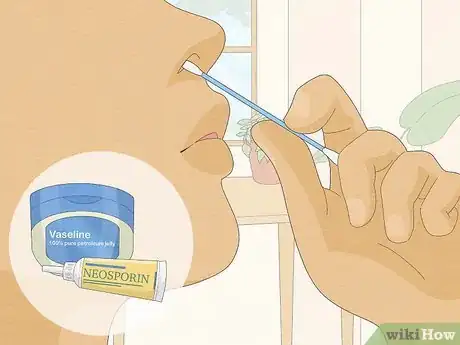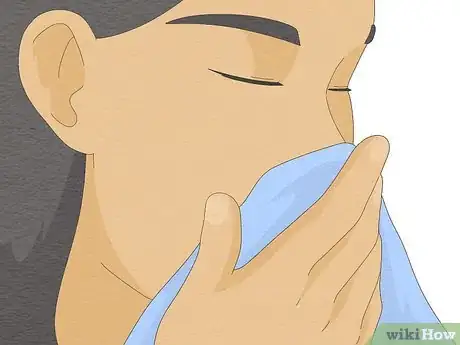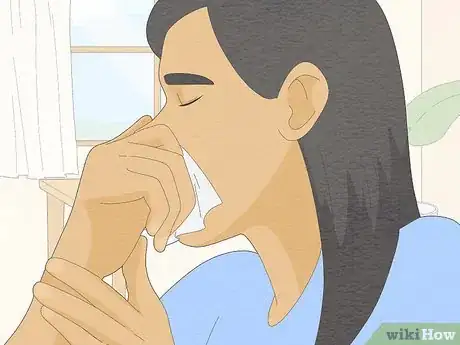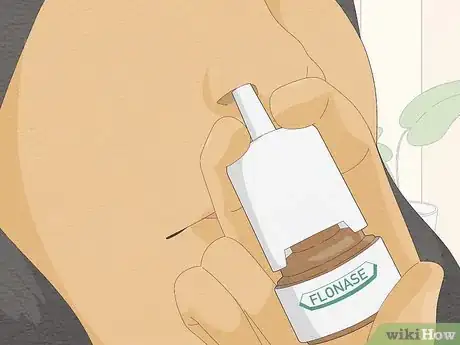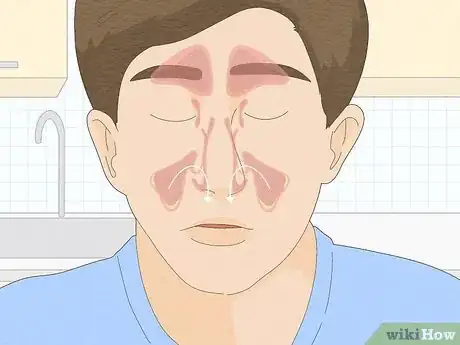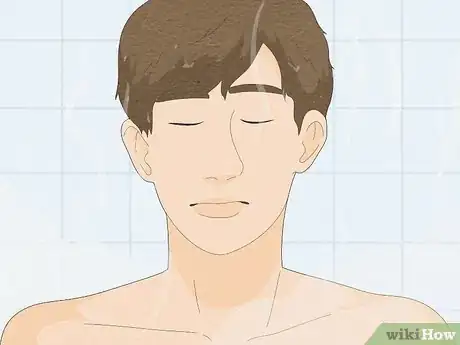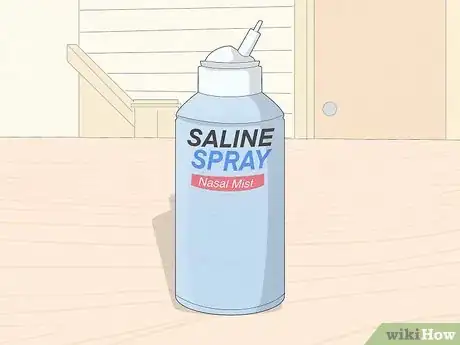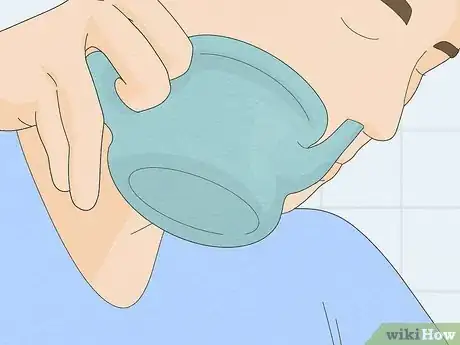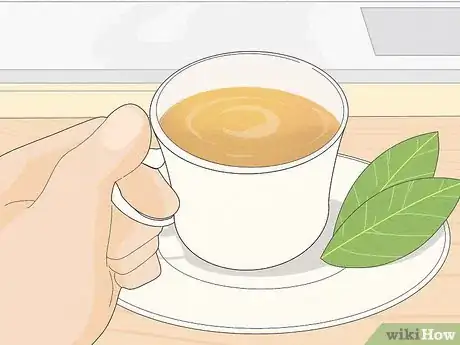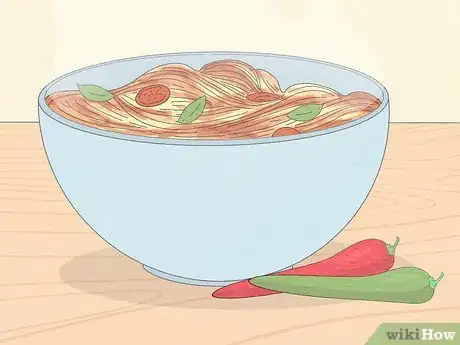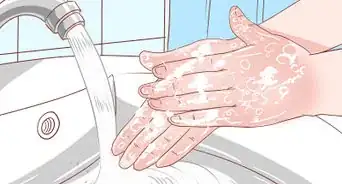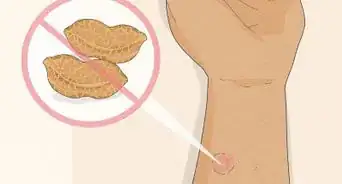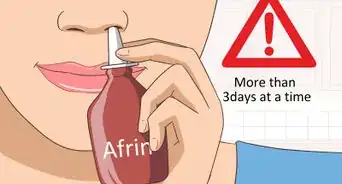This article was co-authored by Alan O. Khadavi, MD, FACAAI. Dr. Alan O. Khadavi is a Board Certified Allergist and a Pediatric Allergy Specialist based in Los Angeles, California. He holds a BS in biochemistry from the State University of New York (SUNY) at Stony Brook and an MD from the State University of New York Health Science Center at Brooklyn. Dr. Khadavi completed his pediatric residency at Schneider Children’s Hospital in New York, and then went on to complete his allergy and immunology fellowship and pediatric residency at Long Island College Hospital. He is board certified in adult and pediatric allergy/immunology. Dr. Khadavi is a Diplomate of the American Board of Allergy and Immunology, a Fellow of the American College of Allergy, Asthma & Immunology (ACAAI), and a member of the American Academy of Allergy, Asthma & Immunology (AAAAI). Dr. Khadavi's honors include Castle Connolly’s list of Top Doctors 2013-2020, and Patient Choice Awards "Most Compassionate Doctor" in 2013 & 2014.
There are 12 references cited in this article, which can be found at the bottom of the page.
This article has been viewed 1,184,888 times.
Frequent blowing from allergies, colds, or cold, dry weather can painfully irritate your nose. The delicate tissues around and in the nose become dry and chapped from the constant "micro-trauma" of blowing and wiping. Allergies can be especially problematic because they last longer than the one to two weeks of a cold or flu. Whatever the cause, there are steps you can take to soothe your tender nose.
Steps
Reducing Irritation and Chafing
-
1Apply a soothing moisturizer to the outside of your nostrils. Petroleum jellies like Vaseline and ointments like Neosporin work best. Place a small amount of the product on a Q-tip, then apply it around the entrance of each nostril. The extra moisture will not only relieve dryness, but will also create a barrier against irritation from a runny nose.[1]
- If you don't have something like Vaseline or Neosporin handy, you can use your regular facial lotion. It won't lock in moisture as effectively, but it should still provide some relief.
-
2Buy tissue with lotion.[2] If you're willing to pay a slightly higher price, splurging on some high-quality facial tissue can go a long way toward soothing your nose. Look for products that have been treated with lotion. They do less damage as you're blowing your nose, and counteract the irritation with their soothing lotion. Less chafing during nose-blowing means less irritation in the long run.Advertisement
-
3Soak your nose with a moist washcloth. If your nose is badly chafed or even bleeding, add warm moisture quickly to relieve the pain. Run a clean washcloth under hot water, then gently press it into the nostrils. Tilt your head back and leave the washcloth in place until it cools back down to room temperature. Breathe through your mouth during this time.
- Apply petroleum jelly or Neosporin to your nose immediately after soaking your nose with a washcloth.
- Either dispose of the washcloth or wash it immediately.
-
4Reduce your nose blowing. A runny or congested nose can feel terrible, and you may be tempted to blow your nose constantly. Though it may be hard, fight that urge. Especially if you're home alone and there's nobody to judge you, blow your nose only when necessary. If a little mucus runs out of your nose, gently dab it away instead of honking on a dry tissue and irritating your nose.
-
5Use gentle nose-blowing technique.[3] Instead of taking a deep breath and blowing as hard as you can, blow gently to reduce chafing. Blow softly through one nostril, then the other. Continue alternating nostrils until you feel your nose is clear enough.
- Always loosen the mucus with a decongesting technique before blowing your nose.
-
6Seek medical treatment for allergies.[4] A doctor will be able to prescribe allergy medications that can control your reaction. Whether you get allergy shots or take Flonase nasal spray when your nose starts running, treating the underlying allergy will help soothe your nose.[5]
- Note that oral decongestants tend to make your mucous even dryer, increasing irritation.
Decongesting Your Nose
-
1Loosen your nasal secretions. There are many methods you can use to liquefy and loosen the secretions blocking up your nose. By setting aside a little time for these techniques, you can improve the efficiency of each nose blowing. Over time, you'll have to blow your nose less frequently, decreasing the chafing on your nose. Try these decongestant techniques throughout the day, and always blow your nose immediately afterward.
-
2Sit in a steamy room. If you belong to a gym with a sauna, that's the perfect place to both loosen nasal congestion and relax after a long day. But if you don't have access to a sauna, you can improvise in your bathroom. Turn on the hot water in the shower, and close the door to keep all the steam in. Stay in the bathroom for three to five minutes or until you feel the secretions are loose and moist. Gently blow your nose before leaving the steamed room.
- To save water, you can just blow your nose when you get out of the shower.
-
3Apply a warm compress to the bridge of the nose. Take a moist washcloth and place it in the microwave until it's warm, but not burning hot. Microwaving time will vary depending on your machine, so start with 30 seconds and add 15 seconds at a time. The washcloth should be hot, but tolerable. Place the cloth across your nose and allow to sit until the heat is gone. The heat should loosen secretions, even when applied from outside the nasal cavity.
- Repeat the process if necessary before blowing your nose.
-
4Irrigate your nose with saline spray.[6] [7] This just means you'll flush your nasal passage with a saline spray. You can buy a nasal saline spray at any grocery store or pharmacy. Spray the bottle twice into each nostril, adding liquid to the secretions and liquefying them. If you don't want to buy a saline spray, you can make a simple one at home:
- Mix eight ounces of warm water with 1/2 teaspoon of salt.
- Buy a suction bulb from the grocery store or pharmacy. Use it to irrigate your nostrils with your homemade saline rinse.
-
5Try using a neti pot. A neti pot looks like a miniature teapot. It clears out blocked sinus passages in the nose by flooding warm water through one nostril and out the other. Heat the water to at least 120 °F (49 °C) to kill anything potentially harmful in the water. Allow the water to cool to a comfortable temperature before using the neti pot. Tilt your head, and pour water into your right nostril. If you keep your head tilted, it will drain out your left nostril.
- Consider skipping the neti pot if you live in an area with inadequate water treatment. There have been some reports of rare amoebic infections from parasites in tap water.[8]
-
6Drink warm tea throughout the day. The throat and nose are closely connected, so drinking warm liquids will also warm up the nasal passage. Just like inhaling steam, this will allow secretions to flow more freely. Any type of tea you prefer is fine, but you may choose to drink a healing herbal tea if you have a cold. Check your grocery store or health store for cold or flu teas. Peppermint and clove teas can soothe a sore throat while freeing up your nose.[9]
-
7Exercise, if your health allows it.[10] If you are bedridden with a cold or flu, you should absolutely get some rest. But if your excessive nose blowing is caused by allergies, exercising is a good option. When your heart rate rises enough to make you break a sweat, it has a beneficial side effect of clearing your nasal secretions. Even 15 minutes of exercise can help, as long as you avoid the allergen. For example, if you're allergic to pollen, don't go running outdoors.
-
8Eat something very spicy. Think about the last time you ate something uncomfortably spicy. Do you remember how your nose started running?[11] That's the ideal state for nose blowing, so power your way through hot salsa, peppers, hot wings — anything to get your nose running. Blow your nose immediately while the secretions are still moist and fluid.
-
9Invest in a humidifier. You can buy a humidifier at the drugstore to keep the air moist as you sleep. Choose a humidifier with a cool mist setting, as a warm mist might make congestion worse. Set the machine to the ideal humidity level — between 45 and 50%.[12]
- A tabletop version holds one to four gallons of water, and should be changed daily. Clean the water container completely by hand every three days.
- The filter, preferably a HEPA, should be changed at the discretion of the manufacturer.
-
10Massage your sinus area.[13] Massaging the areas that affect your sinus may open up your nasal passages and make it easier to blow your nose. For a little extra punch, use rosemary, peppermint, or lavender oil, but make sure not to get it in your eyes. You can rinse your face with a warm compress afterward. Using your index and middle fingers, apply gentle pressure in a circular motion to:
- The forehead (frontal sinus)
- The bridge of the nose and temples (orbital sinus)
- Under the eyes (maxillary sinus)
Expert Q&A
Did you know you can get expert answers for this article?
Unlock expert answers by supporting wikiHow
-
QuestionHow can I stop my hay fever symptoms?
 Alan O. Khadavi, MD, FACAAIDr. Alan O. Khadavi is a Board Certified Allergist and a Pediatric Allergy Specialist based in Los Angeles, California. He holds a BS in biochemistry from the State University of New York (SUNY) at Stony Brook and an MD from the State University of New York Health Science Center at Brooklyn. Dr. Khadavi completed his pediatric residency at Schneider Children’s Hospital in New York, and then went on to complete his allergy and immunology fellowship and pediatric residency at Long Island College Hospital. He is board certified in adult and pediatric allergy/immunology. Dr. Khadavi is a Diplomate of the American Board of Allergy and Immunology, a Fellow of the American College of Allergy, Asthma & Immunology (ACAAI), and a member of the American Academy of Allergy, Asthma & Immunology (AAAAI). Dr. Khadavi's honors include Castle Connolly’s list of Top Doctors 2013-2020, and Patient Choice Awards "Most Compassionate Doctor" in 2013 & 2014.
Alan O. Khadavi, MD, FACAAIDr. Alan O. Khadavi is a Board Certified Allergist and a Pediatric Allergy Specialist based in Los Angeles, California. He holds a BS in biochemistry from the State University of New York (SUNY) at Stony Brook and an MD from the State University of New York Health Science Center at Brooklyn. Dr. Khadavi completed his pediatric residency at Schneider Children’s Hospital in New York, and then went on to complete his allergy and immunology fellowship and pediatric residency at Long Island College Hospital. He is board certified in adult and pediatric allergy/immunology. Dr. Khadavi is a Diplomate of the American Board of Allergy and Immunology, a Fellow of the American College of Allergy, Asthma & Immunology (ACAAI), and a member of the American Academy of Allergy, Asthma & Immunology (AAAAI). Dr. Khadavi's honors include Castle Connolly’s list of Top Doctors 2013-2020, and Patient Choice Awards "Most Compassionate Doctor" in 2013 & 2014.
Board Certified Allergist
-
QuestionWhen I blow my nose the area between my nose and mouth gets red and sore. Is there something I can use to soothe that area?
 Chris M. Matsko, MDDr. Chris M. Matsko is a retired physician based in Pittsburgh, Pennsylvania. With over 25 years of medical research experience, Dr. Matsko was awarded the Pittsburgh Cornell University Leadership Award for Excellence. He holds a BS in Nutritional Science from Cornell University and an MD from the Temple University School of Medicine in 2007. Dr. Matsko earned a Research Writing Certification from the American Medical Writers Association (AMWA) in 2016 and a Medical Writing & Editing Certification from the University of Chicago in 2017.
Chris M. Matsko, MDDr. Chris M. Matsko is a retired physician based in Pittsburgh, Pennsylvania. With over 25 years of medical research experience, Dr. Matsko was awarded the Pittsburgh Cornell University Leadership Award for Excellence. He holds a BS in Nutritional Science from Cornell University and an MD from the Temple University School of Medicine in 2007. Dr. Matsko earned a Research Writing Certification from the American Medical Writers Association (AMWA) in 2016 and a Medical Writing & Editing Certification from the University of Chicago in 2017.
Family Medicine Physician
-
QuestionI have to use a whole box of tissues and it gets annoying. How do I get rid of a stuffy nose?
 Chris M. Matsko, MDDr. Chris M. Matsko is a retired physician based in Pittsburgh, Pennsylvania. With over 25 years of medical research experience, Dr. Matsko was awarded the Pittsburgh Cornell University Leadership Award for Excellence. He holds a BS in Nutritional Science from Cornell University and an MD from the Temple University School of Medicine in 2007. Dr. Matsko earned a Research Writing Certification from the American Medical Writers Association (AMWA) in 2016 and a Medical Writing & Editing Certification from the University of Chicago in 2017.
Chris M. Matsko, MDDr. Chris M. Matsko is a retired physician based in Pittsburgh, Pennsylvania. With over 25 years of medical research experience, Dr. Matsko was awarded the Pittsburgh Cornell University Leadership Award for Excellence. He holds a BS in Nutritional Science from Cornell University and an MD from the Temple University School of Medicine in 2007. Dr. Matsko earned a Research Writing Certification from the American Medical Writers Association (AMWA) in 2016 and a Medical Writing & Editing Certification from the University of Chicago in 2017.
Family Medicine Physician
Warnings
- Seek medical attention if you have a sinus infection or if your cold or flu lasts a week without improvement. Signs include thickening, greenish nasal secretions, and a sinus headache.⧼thumbs_response⧽
- Although it is rare, vaseline applied frequently below the nose may be inhaled into the lungs and cause lipid pneumonia. Avoid applying it too frequently, and switch between multiple moisturizers.⧼thumbs_response⧽
References
- ↑ http://www.vaseline.us/faq.html
- ↑ http://www.ncbi.nlm.nih.gov/pubmed/17610648
- ↑ http://www.wsj.com/articles/whats-the-best-way-to-blow-your-nose-1418663296
- ↑ http://www.mayoclinic.org/diseases-conditions/allergies/in-depth/allergy-medications/art-20047403
- ↑ Alan O. Khadavi, MD, FACAAI. Board Certified Allergist. Expert Interview. 29 July 2020.
- ↑ http://www.mayoclinic.org/diseases-conditions/common-cold/in-depth/health-tip/art-20049170
- ↑ Alan O. Khadavi, MD, FACAAI. Board Certified Allergist. Expert Interview. 29 July 2020.
- ↑ http://blogs.scientificamerican.com/guest-blog/a-brush-with-brain-eating-amoebas-and-saltwater-nose-genies/
- ↑ http://healthyeating.sfgate.com/tea-good-colds-sore-throat-2398.html
About This Article
To soothe a sore and irritated nose, apply moisturizer or petroleum jelly to the outside of your nostrils. You can also hold a warm, moist washcloth on your nose, which will help soothe the pain. Try to avoid blowing your nose as much as possible so you don't irritate it more. If you have to blow your nose, blow gently out of one nostril at a time to prevent further irritation. For more tips from our Physician co-author, like how to break apart congestion, keep reading the article!
